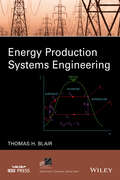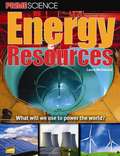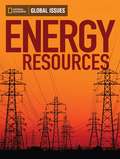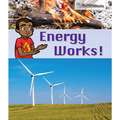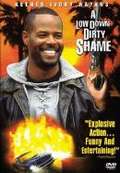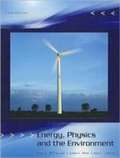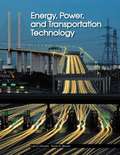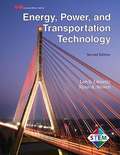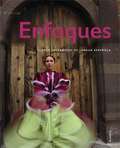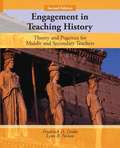- Table View
- List View
Energy Production Systems Engineering
by Thomas Howard BlairEnergy Production Systems Engineering presents IEEE, Electrical Apparatus Service Association (EASA), and International Electrotechnical Commission (IEC) standards of engineering systems and equipment in utility electric generation stations. Includes fundamental combustion reaction equations. Provides methods for measuring radioactivity and exposure limits. Includes IEEE, American Petroleum Institute (API), and National Electrical Manufacturers Association (NEMA) standards for motor applications. Introduces the IEEE C37 series of standards, which describe the proper selections and applications of switchgear. Describes how to use IEEE 80 to calculate the touch and step potential of a ground grid design. This book enables engineers and students to acquire through study the pragmatic knowledge and skills in the field that could take years to acquire through experience alone.
Energy Resources
by Brett Kelly Laura McdonaldA look at the advantages and disadvantages of Earth's renewable and nonrenewable resources.
Energy Resources [Above-Level]
by Andrew J. MilsonExamines the role of traditional sources of energy and the development of alternative energy resources
Energy Works
by Janette SchusterNIMAC-sourced textbook <p><p> Energy Works allows students to explore different kinds of energy and see how energy is converted to different forms.
Energy Works: Below-Grade Reader (Building Blocks of Science Literacy Series)
by Janette SchusterLexile range: 520L–670L. Energy Works Below-Grade Reader encourages students to consider energy in all its different forms. Topics include: Energy and Its Forms; Energy Sources; the Science and Engineering Practices of analyzing data; and a look into the daily life of an electrical engineer.
Energy and Electromagnetism
by Lawrence Hall of Science University of California at BerkeleyNIMAC-sourced textbook
Energy and Matter (iScience)
by Alton L. BiggsIScience meets students where they are through engaging features and thought-provoking questions that encourage them to relate the science concepts to the world around them.
Energy and the Environment: Sources, Technologies, and Impacts
by Reza ToossiEnergy and the Environment is conceived and written at a level suitable for use as an introductory undergraduate textbook in energy and environment for students with very little mathematics or science background. It can also be used by anyone interested in technical, political, environmental, and economical issues related to energy. To make the text appropriate for engineering and science students, additional topics are included within information boxes placed throughout the book, and in the appendices. Examples requiring algebra are indicated in a similar manner. Depending on the audience, instructors can decide to eliminate all or part of this material without loss of continuity. Each chapter in Energy and the Environment stands alone, and the text can be taught in any order that the instructor deems suitable. Widely different curricula can therefore be designed and tailored for any audience simply by focusing on the appropriate sections from the appropriate chapters. For example, an environmental engineering course might include the summaries of various energy sources types, with an emphasis on air pollution, radiation, and environmental economics. A science curriculum might alternately emphasize the various technological sections and incorporate some of the engineering designs. This book is now available and can be purchased at http://vervepublishers.com. You may also order a free examination copy if you are considering adopting the Energy and the Environment for your classes. I would be most pleased to receive comments and thank you for your time!
Energy in the Atmosphere (Inspire Science, Grade 6 Integrated #Unit 3)
by Douglas Fisher Ralph M. Feather Alton L. BiggsNIMAC-sourced textbook
Energy, Machines, and Motion: Student Guide and Source Book
by National Science Resources CenterNIMAC-sourced textbook
Energy, Physics And The Environment
by J. L. Campbell E. L. McFarland J. L. HuntEnergy, Physics and the Environment provides a foundational quantitative account of energy and related environmental issues for university students in science who have a first-year preparation in Physics. The text discusses the numbers involved in the various dimensions of the overall energy issue in order to help the reader develop a quantitative grasp on them. This third edition book features an expanded section on uranium resources and the most updated data available. Energy, Physics and the Environment gives students the opportunity to study current energy supply concerns and the impact that energy supply shortage has on the environment.
Energy, Power, And Transportation Technology
by Jack Klasey Ryan A. Brown Len S. LitowitzEnergy, Power, and Transportation Technology provides a comprehensive study of the basic elements of energy, power, and transportation and how they affect the world we live in. This textbook covers the resources, processes, and systems used in these industries. For maximum teaching andlearning flexibility, chapter objectives are divided into Basic Concepts, Intermediate Concepts, and Advanced Concepts. Activities are provided at the end of each chapter to help the student apply the concepts covered in that chapter. Technology Links and Curricular Connections in each chapter helpbroaden student knowledge of technology and connect chapter content with concepts in math, science, and social studies.
Energy, Power, and Transportation Technology
by Ryan Brown Jack Klasey Len LitowitzNIMAC-sourced textbook
Enfin l'aurore!
by Orokiatou BaroCe recueil de quatre nouvelles plonge le lecteur dans l'univers de quatre adolescents qui traversent chacun des situations éprouvantes et tentent de trouver des ressources en eux- même pour en sortir plus mature. Que ce soit dans un trou d'or, sur un lit d'hôpital, entre les griffes d'un malfaiteur ou encore dans le deuil d'une mère, les protagonistes de chaque nouvelle feront des rencontres édifiantes dans cette quête de soi. Construire sa propre personnalité en dépit des aléas de la vie et du regard des autres, oser prendre des décisions difficiles pour changer son destin, savoir composer avec les conseils des personnes avisées, rêver grand pour espérer triompher sur la misère d'aujourd'hui, telle est 1 'option qui s'impose à chacun d'eux.
Enforcing Rules
by Tara Funk Vickey Herold6 copies of Book with Teacher's Guide and Comprehension Question Card
Enfrentados a la naturaleza: Textos Para La Lectura Atenta (Texts Close Reading Ser.)
by Benchmark Education Co.NIMAC-sourced textbook
Engagement in Teaching History: Theory and Practices for Middle and Secondary Teachers
by Frederick D. Drake Lynn R. NelsonWith an emphasis on engaging students in historical inquiry, problem solving, and discussion, Engagement in Teaching History offers a wealth of ideas for prospective teachers of history. The book addresses the selection of content, methods of instruction, and ways to assess students' learning. By following the text's guidelines for involving learners in historical inquiry, teaching toward chronological thinking, encouraging deliberative discussions, and using primary sources, teachers will ignite students' innate "detective" instincts and encourage them to think critically about historical events.
